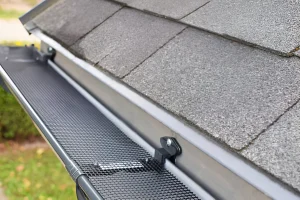Gutters play a pivotal role in protecting homes from water damage, directing rainfall away from the structure and its foundation. The efficiency of this drainage process is determined by the gutter flow rates. Understanding and optimizing these flow rates is essential for ensuring the effectiveness of the gutter system. In this comprehensive guide, we delve into the factors influencing gutter flow rates, the importance of proper drainage, strategies for optimization, and the role of maintenance in preserving a home’s structural integrity.
Understanding Gutter Flow Rates
Definition:
Gutter flow rates (Optimizing Gutter Flow Rates)refer to the speed at which water moves through the gutters and downspouts during a rainfall event.
Importance:
Efficient flow rates are crucial for preventing water buildup, which can lead to issues like roof leaks, foundation damage, and compromised landscaping.
Factors Influencing Gutter Flow Rates
Roof Size and Pitch:
The larger the roof, the more water runoff it produces. Additionally, steeper roof pitches result in faster water runoff, influencing flow rates.
Downspout Size and Placement:
Properly sized downspouts and strategic placement are essential for facilitating the quick and effective drainage of water.
Gutter Size and Material:
The size and material of the gutters themselves impact flow rates. Larger gutters can handle more water, and materials like aluminum or copper provide durability.
Preventing Water Damage:
Adequate flow rates prevent water from pooling on the roof or overflowing the gutters, safeguarding the home against water-related damage.
Preserving Foundation Integrity:
Proper drainage prevents water from accumulating around the foundation, minimizing the risk of cracks, leaks, and other foundation issues.
Avoiding Landscape Erosion:
Efficient flow rates protect landscaping by preventing soil erosion caused by excess water runoff.
Strategies for Optimizing Gutter Flow Rates
Gutter Sizing Guidelines:
Follow industry guidelines to determine the appropriate gutter size based on factors such as roof area, pitch, and local rainfall patterns.
Downspout Considerations:
Ensure downspouts are strategically placed and adequately sized to handle the volume of water flowing from the gutters.
Regular Maintenance:
Cleaning gutters and downspouts regularly prevents clogs, ensuring unobstructed water flow. This is especially important during seasons with increased debris.
Gutter Guards:
Installing gutter guards can reduce debris buildup, allowing for smoother water flow and minimizing the need for frequent cleaning.
Maintenance Practices for Optimal Flow Rates
Seasonal Cleaning:
Schedule gutter cleaning at least twice a year, ideally in spring and fall, to remove debris and prevent clogs.
Inspecting for Damage:
Regularly inspect gutters and downspouts for signs of damage such as leaks, sagging, or corrosion, addressing issues promptly.
Winter Preparation:
Prepare gutters for winter by ensuring they are free of debris and inspecting for any potential issues that could lead to ice dams.
Ensuring Effective Gutter Performance
Optimizing gutter flow rates is a proactive approach to preserving a home’s structural integrity and protecting against water damage. By understanding the factors influencing flow rates, implementing strategies for optimization, and committing to regular maintenance practices, homeowners can ensure that their gutter systems function effectively throughout the year. As the first line of defense against water-related issues, well-maintained gutters contribute to the overall longevity and resilience of residential structures.
Frequently Asked Questions (FAQ) – Optimizing Gutter Flow Rates: A Comprehensive Guide
Q: Why are gutter flow rates important for homes?
A: Gutter flow rates are crucial for effective water drainage, preventing issues such as water damage, foundation problems, and landscaping erosion. Proper flow rates ensure that rainwater is efficiently directed away from the home.
Q: How does roof size and pitch affect gutter flow rates?
A: Larger roofs and steeper pitches result in increased water runoff, impacting gutter flow rates. It’s essential to consider these factors when determining the appropriate gutter size and capacity.
Q: What role do downspouts play in optimizing gutter flow rates?
A: Downspouts are integral to the drainage process. Properly sized and strategically placed downspouts ensure efficient water flow from the gutters, preventing overflow and water-related issues.
Q: Why does gutter size and material matter for flow rates?
A: The size of gutters directly influences their capacity to handle water flow. Larger gutters can accommodate more water. Additionally, durable materials like aluminum or copper contribute to long-lasting performance.
Q: How do proper gutter flow rates prevent water damage?
A: Adequate flow rates prevent water from pooling on the roof or overflowing the gutters, minimizing the risk of water damage to the home’s interior, exterior, and foundation.
Q: Can gutter guards help optimize flow rates?
A: Yes, gutter guards can reduce debris buildup, allowing for smoother water flow and minimizing the need for frequent cleaning. They contribute to maintaining optimal gutter performance.
Q: How often should gutters be cleaned to maintain optimal flow rates?
A: Regular cleaning is recommended at least twice a year, typically in spring and fall. This helps remove debris, preventing clogs and ensuring unobstructed water flow.
Q: What steps can homeowners take to prepare gutters for winter?
A: Winter preparation includes cleaning gutters of debris, inspecting for potential issues that could lead to ice dams, and ensuring the system is ready to handle winter weather conditions.
Q: Are there specific guidelines for gutter sizing based on regional factors?
A: Yes, industry guidelines consider factors such as local rainfall patterns, roof area, and pitch when determining the appropriate gutter size for optimal flow rates.
Q: How does gutter maintenance contribute to overall home resilience?
A: Regular maintenance practices, including cleaning, inspections, and addressing issues promptly, contribute to the overall effectiveness of the gutter system. Well-maintained gutters enhance the longevity and resilience of residential structures.
Q: Can homeowners optimize gutter flow rates without professional assistance?
A: While some maintenance tasks can be performed by homeowners, professional assistance may be necessary for repairs, upgrades, or addressing complex issues affecting flow rates.
Q: How can homeowners ensure their gutters function effectively throughout the year?
A: Ensuring effective gutter performance involves understanding the factors influencing flow rates, implementing optimization strategies, and committing to regular maintenance practices. This proactive approach preserves a home’s structural integrity and protects against water-related issues.






